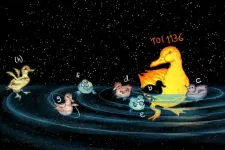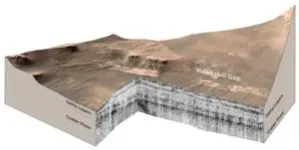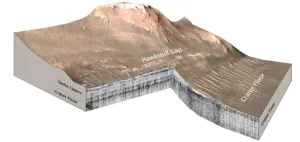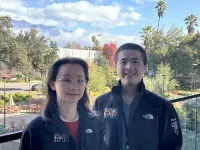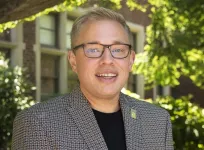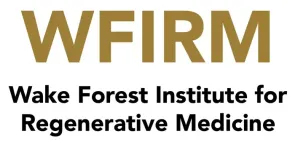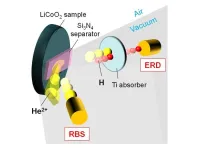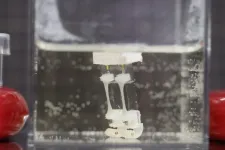(Press-News.org) A recently discovered solar system with six confirmed exoplanets and a possible seventh is boosting astronomers’ knowledge of planet formation and evolution. Relying on a globe-spanning arsenal of observatories and instruments, a team led by researchers at the University of California, Irvine has compiled the most precise measurements yet of the exoplanets’ masses, orbital properties and atmospheric characteristics.
In a paper published today in The Astronomical Journal, the researchers share the results of the TESS-Keck Survey, providing a thorough description of the exoplanets orbiting TOI-1136, a dwarf star in the Milky Way galaxy more than 270 light years from Earth. The study is a follow-up to the team’s initial observation of the star and exoplanets in 2019 using data from the Transiting Exoplanet Survey Satellite. That project provided the first estimate of the exoplanets’ masses by clocking transit timing variations, a measure of the gravitational pull that orbiting planets exert on one another.
For the most recent study, the researchers joined TTV data with a radial velocity analysis of the star. Using the Automated Planet Finder telescope at the Lick Observatory on California’s Mount Hamilton and the High-Resolution Echelle Spectrometer at the W.M. Keck Observatory on Hawaii’s Mauna Kea, they could detect slight variations in stellar motion via the redshift and blueshift of the Doppler effect – which helped them determine planetary mass readings of unprecedented precision.
To obtain such exact information on the planets in this solar system, the team built computer models using hundreds of radial velocity measurements layered over TTV data. Lead author Corey Beard, a UCI Ph.D. candidate in physics, said that combining these two types of readings yielded more knowledge about the system than ever before.
“It took a lot of trial and error, but we were really happy with our results after developing one of the most complicated planetary system models in exoplanet literature to date,” Beard said.
The large number of planets is one factor that inspired the astronomy team to conduct further research, according to co-author Paul Robertson, UCI associate professor of physics & astronomy.
“We viewed TOI-1136 as being highly advantageous from a research standpoint, because when a system has multiple exoplanets, we can control for the effects of planet evolution that depend on the host star, and that helps us focus on individual physical mechanisms that led to these planets having the properties that they do,” he said.
Robertson added that when astronomers try to compare planets in separate solar systems, there are many variables that can differ based on the distinct properties of the stars and their locations in disparate parts of the galaxy. He said that looking at exoplanets in the same system enables the study of planets that have experienced a similar history.
By stellar standards, TOI-1136 is young, a mere 700 million years old, another feature that has attracted exoplanet hunters. Robertson said that juvenile stars are both “difficult and special” to work with because they’re so active. Magnetism, sunspots and solar flares are more prevalent and intense during this stage of a star’s development, and the resulting radiation blasts and sculpts planets, affecting their atmospheres.
TOI-1136’s confirmed exoplanets, TOI-1136 b through TOI-1136 g, are categorized as “sub-Neptunes” by the experts. Robertson said the smallest one is more than twice the radius of Earth, and others are up to four times Earth’s radius, comparable to the sizes of Uranus and Neptune.
All these planets orbit TOI-1136 in less than the 88 days it takes Mercury to go around Earth’s sun, according to the study. “We’re packing an entire solar system into a region around the star so small that our entire planetary system here would be outside of it,” Robertson said.
“They’re weird planets to us because we don’t have anything exactly like them in our solar system,” said co-author Rae Holcomb, a UCI Ph.D. candidate in physics. “But the more we study other planet systems, it seems like they may be the most common type of planet in the galaxy.”
Another odd component to this solar system is the possible yet unconfirmed presence of a seventh planet. The researchers have detected some evidence of another resonant force in the system. Robertson explained that when planets are orbiting close to one another, they can pull on each other gravitationally.
“When you hear a chord played on a piano and it sounds good to you, it’s because there is resonance, or even spacing, between the notes that you’re hearing,” he said. “The orbital periods of these planets are spaced similarly. When the exoplanets are in resonance, the tugs are in the same direction every time. This can have a destabilizing effect, or in special cases, it can serve to make the orbits more stable.”
Robertson noted that far from answering all his team’s questions about the exoplanets in this system, the survey has made the researchers want to pursue additional knowledge, particularly about the composition of planetary atmospheres. That line of inquiry would be best approached through the advanced spectroscopy capabilities of NASA’s James Webb Space Telescope, he said.
“I am proud that both UCO’s Lick Observatory and the Keck Observatories were involved in the characterization of a really important system,” said Matthew Shetrone, deputy director of UC Observatories. “Having so many moderate-sized planets in the same system really lets us test formation scenarios. I really want to know more about these planets! Might we find a molten rock world, a water world and an ice world all in the same solar system? It almost feels like science fiction.”
Joining Robertson and Beard on this study were researchers from Spain’s Astrophysics Institute of the Canary Islands; the California Institute of Technology; Sweden’s Chalmers University of Technology; Maryland’s Johns Hopkins University; Spain’s University of La Laguna; Sweden’s Lund University; Poland’s Nicolaus Copernicus University; New Jersey’s Princeton University; Japan’s Ritsumeikan University; California’s SETI Institute; Maryland’s Space Telescope Science Institute; the University of California, Santa Cruz; the University of California, Berkeley; the University of California, Los Angeles; the University of California, Riverside; the University of Hawaii; the University of Chicago; the University of Kansas; Indiana’s University of Notre Dame; Australia’s University of Southern Queensland; and Connecticut’s Yale University. Funding was provided by the W.M. Keck Foundation, NASA and the National Science Foundation.
About the University of California, Irvine: Founded in 1965, UCI is a member of the prestigious Association of American Universities and is ranked among the nation’s top 10 public universities by U.S. News & World Report. The campus has produced five Nobel laureates and is known for its academic achievement, premier research, innovation and anteater mascot. Led by Chancellor Howard Gillman, UCI has more than 36,000 students and offers 224 degree programs. It’s located in one of the world’s safest and most economically vibrant communities and is Orange County’s second-largest employer, contributing $7 billion annually to the local economy and $8 billion statewide. For more on UCI, visit www.uci.edu.
Media access: Radio programs/stations may, for a fee, use an on-campus ISDN line to interview UCI faculty and experts, subject to availability and university approval. For more UCI news, visit news.uci.edu. Additional resources for journalists may be found at https://news.uci.edu/media-resources/.
END
UC Irvine-led team unravels mysteries of planet formation and evolution in distant solar system
Astronomers analyze masses, orbital properties and atmospheric features of six exoplanets
2024-01-26
ELSE PRESS RELEASES FROM THIS DATE:
Confirmation of ancient lake on Mars builds excitement for Perseverance rover's samples
2024-01-26
If life ever existed on Mars, the Perseverance rover’s verification of lake sediments at the base of the Jezero crater reinforces the hope that traces might be found in the crater.
In new research published in the journal Science Advances, a team led by UCLA and The University of Oslo shows that at some point, the crater filled with water, depositing layers of sediments on the crater floor. The lake subsequently shrank and sediments carried by the river that fed it formed an enormous delta. As the lake dissipated over time, the sediments in the crater were eroded, forming ...
USC Stem Cell study shows how gene activity modulates the amount of immune cell production in mice
2024-01-26
As people age or become ill, their immune systems can become exhausted and less capable of fighting off viruses such as the flu or COVID-19. In a new mouse study funded in part by the National Institutes of Health and published in Science Advances, researchers from the USC Stem Cell lab of Rong Lu describe how specific gene activity could potentially enhance immune cell production.
“Hematopoietic stem cells, or HSCs, produce blood and immune cells, but not all HSCs are equally productive,” said the study’s corresponding author Rong Lu, PhD, ...
How waves and mixing drive coastal upwelling systems
2024-01-26
They are among the most productive and biodiverse areas of the world's oceans: coastal upwelling regions along the eastern boundaries of the Atlantic and Pacific Oceans. There, equatorward winds cause near-surface water to move away from the coast. This brings cold, nutrient-rich water from the depths to the surface, inducing the growth of phytoplankton and providing the basis for a rich marine ecosystem in these regions.
In some tropical regions, however, productivity is high even when the upwelling favourable winds are ...
How a timekeeping gene affects tumor growth depends entirely on context
2024-01-26
JANUARY 23, 2024, NEW YORK – A Ludwig Cancer Research study has found that the circadian clock—which synchronizes physiological and cellular activities with the day-night cycle and is generally thought to be tumor suppressive—in fact has a contextually variable role in cancer.
“A lot of evidence suggests that the biological clock is broken in cancer cells, so we expected its disruption would fuel tumor growth in mouse models of melanoma,” said Chi Van Dang, scientific director of the Ludwig Institute for Cancer Research, who led the study with Research Associate Xue Zhang. “But, contrary to our expectations, ...
UT Extension Consumer Economics Specialist named National Educator of the Year for 2023
2024-01-26
An assistant professor and consumer economics specialist with University of Tennessee Extension has been recognized by the Association for Financial Counseling and Planning Education (AFCPE) as the organization’s Educator of the Year for 2023. Christopher Sneed was among ten individuals, organizations, special projects and initiatives expanding access to personal finance resources and education across the country recognized as part of the 2023 AFCPE Awards late last year.
The AFCPE’s Mary Ellen Edmondson Educator of the Year Award honors ...
Female reproductive milestones may be risk factors for diabetes and high cholesterol later in life
2024-01-26
Boston, MA – A new review of available evidence led by researchers at the Harvard Pilgrim Health Care Institute suggests that female reproductive characteristics may be overlooked as risk factors that contribute to later metabolic dysfunction.
The review, “Reproductive risk factors across the female lifecourse and later metabolic health,” was published in the January 26 edition of Cell Metabolism.
Metabolic health is characterized by optimal blood glucose, lipids, blood pressure, and body fat. Alterations in these characteristics may lead to the development of type 2 diabetes or cardiovascular disease.
“Our ...
Using fMRI, new vision study finds promising model for restoring cone function
2024-01-26
In the retinas of human eyes, the cones are photoreceptor cells responsible for color vision, daylight vision, and the perception of small details. As vision scientists from the Division of Experimental Retinal Therapies at the University of Pennsylvania School of Veterinary Medicine, Gustavo D. Aguirre and William A. Beltran have been working for decades to identify the basis of inherited retinal diseases. They previously showed they could recover missing cone function by reintroducing a copy of the normal gene in photoreceptor cells.
Both ...
Wake Forest Institute for Regenerative Medicine awarded $160 million 10-year US National Science Foundation Regional Innovation Engines grant
2024-01-26
WINSTON-SALEM, NC, January 26, 2024 – The Wake Forest Institute for Regenerative Medicine (WFIRM) is the recipient of an inaugural U.S. National Science Foundation (NSF) Engines Program award. The NSF Engines: Piedmont Triad Regenerative Medicine Engine is a regional project that provides an innovation ecosystem to stimulate workforce development, job creation, and economic growth through the development of technologies that benefit the emerging industry. The Piedmont Triad Regenerative Medicine Engine team is led by WFIRM, and includes Forsyth Technical Community College (FTCC), North Carolina Agricultural and Technical State University (N.C. A&T), the RegenMed Development ...
Powering the future: Unlocking the role of hydrogen in lithium-ion batteries
2024-01-26
Lithium-ion batteries stand out as one of the most prevalent rechargeable battery technologies in the present era. Within these batteries, lithium-cobalt oxides (LiCoO2) are widely used as the materials for positive electrodes or cathodes (the conductors through which electric current either enters or exits a substance). The cathode plays a pivotal role in lithium-ion batteries and influences their capacity, performance over many charge-discharge cycles, and ability to manage heat.
One major issue leading to the deterioration of these batteries is the creation of hydrogen through the splitting of water. Therefore, gaining insights into how hydrogen builds ...
Scientists design a two-legged robot powered by muscle tissue
2024-01-26
Compared to robots, human bodies are flexible, capable of fine movements, and can convert energy efficiently into movement. Drawing inspiration from human gait, researchers from Japan crafted a two-legged biohybrid robot by combining muscle tissues and artificial materials. Publishing on January 26 in the journal Matter, this method allows the robot to walk and pivot.
“Research on biohybrid robots, which are a fusion of biology and mechanics, is recently attracting attention as a new field of robotics featuring biological function,” says corresponding author Shoji Takeuchi of the University of Tokyo, Japan. “Using muscle ...
LAST 30 PRESS RELEASES:
Singapore scientists discover lung cancer's "bodyguard system" - and how to disarm it
Bacteria use wrapping flagella to tunnel through microscopic passages
New critique prompts correction of high-profile Yellowstone aspen study, highlighting challenges in measuring ecosystem response to wolf reintroduction
Stroke survivors miss critical treatment, face greater disability due to systemic transfer delays
Delayed stroke care linked to increased disability risk
Long term use of anti-acid drugs may not increase stomach cancer risk
Non-monetary 'honor-based' incentives linked to increased blood donations
Natural ovulation as effective as hormones before IVF embryo transfer
Major clinical trial provides definitive evidence of impacts of steroid treatment on severe brain infection
Low vitamin D levels shown to raise risk of hospitalization with potentially fatal respiratory tract infections by 33%
Diagnoses of major conditions failing to recover since the pandemic
Scientists solve 66 million-year-old mystery of how Earth’s greenhouse age ended
Red light therapy shows promise for protecting football players’ brains
Trees — not grass and other greenery — associated with lower heart disease risk in cities
Chemical Insights scientist receives Achievement Award from the Society of Toxicology
Breakthrough organic crystalline material repairs itself in extreme cold temperatures, unlocking new possibilities for space and deep-sea technologies
Scientists discover novel immune ‘traffic controller’ hijacked by virus
When tropical oceans were oxygen oases
Positive interactions dominate among marine microbes, six-year study reveals
Safeguarding the Winter Olympics-Paralympics against climate change
Most would recommend RSV immunizations for older and pregnant people
Donated blood has a shelf life. A new test tracks how it's aging
Stroke during pregnancy, postpartum associated with more illness, job status later
American Meteorological Society announces new executive director
People with “binge-watching addiction” are more likely to be lonely
Wild potato follows a path to domestication in the American Southwest
General climate advocacy ad campaign received more public engagement compared to more-tailored ad campaign promoting sustainable fashion
Medical LLMs may show real-world potential in identifying individuals with major depressive disorder using WhatsApp voice note recordings
Early translational study supports the role of high-dose inhaled nitric oxide as a potential antimicrobial therapy
AI can predict preemies’ path, Stanford Medicine-led study shows
[Press-News.org] UC Irvine-led team unravels mysteries of planet formation and evolution in distant solar systemAstronomers analyze masses, orbital properties and atmospheric features of six exoplanets
